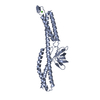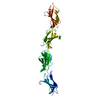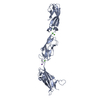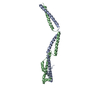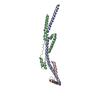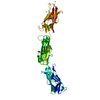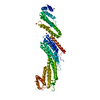[English] 日本語
 Yorodumi
Yorodumi- SASDAS6: Plectin, fragment of the plakin domain encompassing the spectrin ... -
+ Open data
Open data
- Basic information
Basic information
| Entry | Database: SASBDB / ID: SASDAS6 |
|---|---|
 Sample Sample | Plectin, fragment of the plakin domain encompassing the spectrin repeats SR3-SR4-SR5 and the SH3
|
| Function / homology |  Function and homology information Function and homology informationprotein-containing complex organization / actomyosin contractile ring assembly actin filament organization / tight junction organization / Type I hemidesmosome assembly / skeletal myofibril assembly / hemidesmosome assembly / hemidesmosome / leukocyte migration involved in immune response / intermediate filament organization / intermediate filament cytoskeleton organization ...protein-containing complex organization / actomyosin contractile ring assembly actin filament organization / tight junction organization / Type I hemidesmosome assembly / skeletal myofibril assembly / hemidesmosome assembly / hemidesmosome / leukocyte migration involved in immune response / intermediate filament organization / intermediate filament cytoskeleton organization / dystroglycan binding / fibroblast migration / cellular response to hydrostatic pressure / adherens junction organization / regulation of vascular permeability / costamere / T cell chemotaxis / cellular response to fluid shear stress / peripheral nervous system myelin maintenance / intermediate filament cytoskeleton / myoblast differentiation / cardiac muscle cell development / podosome / structural constituent of muscle / ankyrin binding / Assembly of collagen fibrils and other multimeric structures / sarcomere organization / response to food / nucleus organization / keratinocyte development / transmission of nerve impulse / brush border / sarcoplasm / Caspase-mediated cleavage of cytoskeletal proteins / establishment of skin barrier / skeletal muscle fiber development / respiratory electron transport chain / mitochondrion organization / wound healing / cellular response to mechanical stimulus / sarcolemma / structural constituent of cytoskeleton / multicellular organism growth / Z disc / cell morphogenesis / actin filament binding / intracellular protein localization / myelin sheath / gene expression / mitochondrial outer membrane / cadherin binding / axon / focal adhesion / dendrite / perinuclear region of cytoplasm / RNA binding / extracellular exosome / identical protein binding / plasma membrane / cytosol Similarity search - Function |
| Biological species |  Homo sapiens (human) Homo sapiens (human) |
 Citation Citation |  Journal: J Biol Chem / Year: 2011 Journal: J Biol Chem / Year: 2011Title: The structure of the plakin domain of plectin reveals a non-canonical SH3 domain interacting with its fourth spectrin repeat. Authors: Esther Ortega / Rubén M Buey / Arnoud Sonnenberg / José M de Pereda /  Abstract: Plectin belongs to the plakin family of cytoskeletal crosslinkers, which is part of the spectrin superfamily. Plakins contain an N-terminal conserved region, the plakin domain, which is formed by an ...Plectin belongs to the plakin family of cytoskeletal crosslinkers, which is part of the spectrin superfamily. Plakins contain an N-terminal conserved region, the plakin domain, which is formed by an array of spectrin repeats (SR) and a Src-homology 3 (SH3), and harbors binding sites for junctional proteins. We have combined x-ray crystallography and small angle x-ray scattering (SAXS) to elucidate the structure of the central region of the plakin domain of plectin, which corresponds to the SR3, SR4, SR5, and SH3 domains. The crystal structures of the SR3-SR4 and SR4-SR5-SH3 fragments were determined to 2.2 and 2.95 Å resolution, respectively. The SH3 of plectin presents major alterations as compared with canonical Pro-rich binding SH3 domains, suggesting that plectin does not recognize Pro-rich motifs. In addition, the SH3 binding site is partially occluded by an intramolecular contact with the SR4. Residues of this pseudo-binding site and the SR4/SH3 interface are conserved within the plakin family, suggesting that the structure of this part of the plectin molecule is similar to that of other plakins. We have created a model for the SR3-SR4-SR5-SH3 region, which agrees well with SAXS data in solution. The three SRs form a semi-flexible rod that is not altered by the presence of the SH3 domain, and it is similar to those found in spectrins. The flexibility of the plakin domain, in analogy with spectrins, might contribute to the role of plakins in maintaining the stability of tissues subject to mechanical stress. |
 Contact author Contact author |
|
- Structure visualization
Structure visualization
| Structure viewer | Molecule:  Molmil Molmil Jmol/JSmol Jmol/JSmol |
|---|
- Downloads & links
Downloads & links
-Data source
| SASBDB page |  SASDAS6 SASDAS6 |
|---|
-Related structure data
- External links
External links
| Related items in Molecule of the Month |
|---|
-Models
| Model #218 |  Type: dummy / Software: DAMMIF / Radius of dummy atoms: 3.00 A / Chi-square value: 1.48328041  Search similar-shape structures of this assembly by Omokage search (details) Search similar-shape structures of this assembly by Omokage search (details) |
|---|
- Sample
Sample
 Sample Sample | Name: Plectin, fragment of the plakin domain encompassing the spectrin repeats SR3-SR4-SR5 and the SH3 Specimen concentration: 1.20-9.60 |
|---|---|
| Buffer | Name: Sodium Phosphate / Concentration: 20.00 mM / pH: 7.5 / Composition: 150 mM NaCl, 5% glycerol, 2.5 mM DTT |
| Entity #132 | Type: protein / Description: Plectin / Formula weight: 42.896 / Num. of mol.: 1 / Source: Homo sapiens / References: UniProt: Q15149 Sequence: ELEDSTLRYL QDLLAWVEEN QHRVDGAEWG VDLPSVEAQL GSHRGLHQSI EEFRAKIERA RSDEGQLSPA TRGAYRDCLG RLDLQYAKLL NSSKARLRSL ESLHSFVAAA TKELMWLNEK EEEEVGFDWS DRNTNMTAKK ESYSALMREL ELKEKKIKEL QNAGDRLLRE ...Sequence: ELEDSTLRYL QDLLAWVEEN QHRVDGAEWG VDLPSVEAQL GSHRGLHQSI EEFRAKIERA RSDEGQLSPA TRGAYRDCLG RLDLQYAKLL NSSKARLRSL ESLHSFVAAA TKELMWLNEK EEEEVGFDWS DRNTNMTAKK ESYSALMREL ELKEKKIKEL QNAGDRLLRE DHPARPTVES FQAALQTQWS WMLQLCCCIE AHLKENAAYF QFFSDVREAE GQLQKLQEAL RRKYSCDRSA TVTRLEDLLQ DAQDEKEQLN EYKGHLSGLA KRAKAVVQLK PRHPAHPMRG RLPLLAVCDY KQVEVTVHKG DECQLVGPAQ PSHWKVLSSS GSEAAVPSVC FLVPPPNQEA QEAVTRLEAQ HQALVTLWHQ LHVDMK |
-Experimental information
| Beam | Instrument name: Swiss Light Source cSAXS / City: Villigen / 国: Switzerland  / Type of source: X-ray synchrotron / Wavelength: 0.1 Å / Dist. spec. to detc.: 2.15 mm / Type of source: X-ray synchrotron / Wavelength: 0.1 Å / Dist. spec. to detc.: 2.15 mm | ||||||||||||||||||
|---|---|---|---|---|---|---|---|---|---|---|---|---|---|---|---|---|---|---|---|
| Detector | Name: Pilatus 2M | ||||||||||||||||||
| Scan |
| ||||||||||||||||||
| Distance distribution function P(R) |
| ||||||||||||||||||
| Result | Comments: Use of SAXS to analyze the structure of central region of the plakin domain of plectin.
|
 Movie
Movie Controller
Controller


